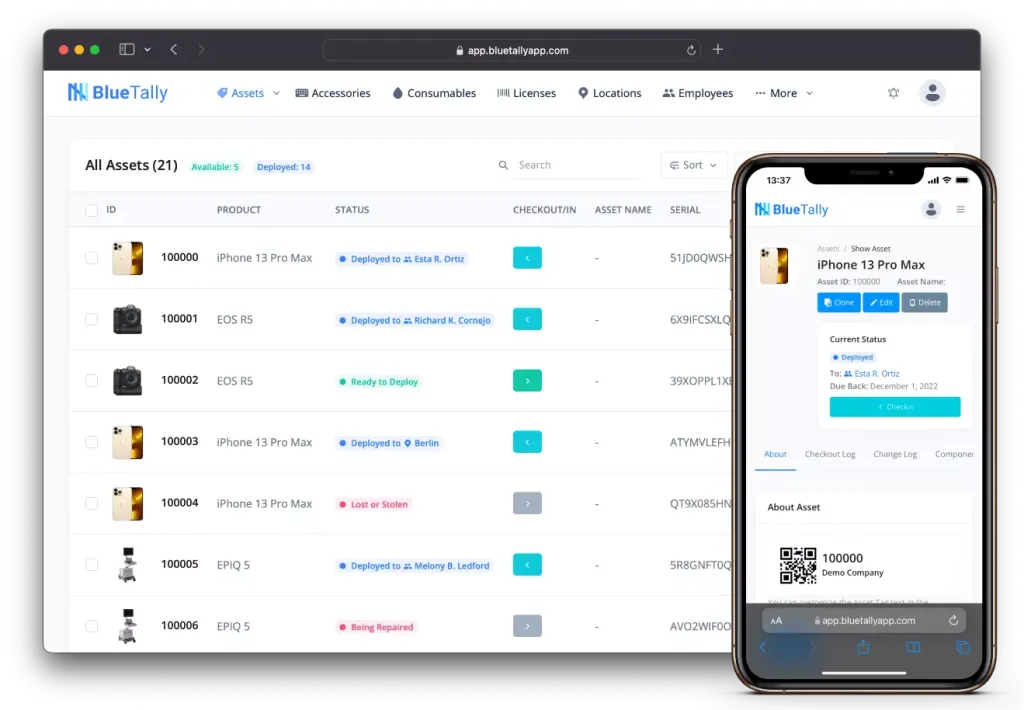How to Create an Asset Management Plan

Asset management involves a lot of steps, from asset audits and maintenance to liability management. With so many things to take care of, it’s easy to make mistakes. That’s why it’s crucial for you to create an asset management plan, where you can devise a proper strategy to help you optimize your processes.
When creating your asset management plan, you should look into cloud-based asset management software such as BlueTally. Having a simple online management system makes it much easier to keep track of your assets.
Want to learn more about asset management plans? Read on.
What is an Asset Management Plan?
An asset management plan consists of tactics and strategies that help you reach a certain standard of service. It should streamline your operations and allow you to improve your asset management practices. For example, you can invest in asset management software like BlueTally to simplify tasks such as asset audits, checkouts, and asset tagging.

Different Types of Asset Management
IT Asset Management
IT asset management involves overseeing and maintaining IT assets such as software systems and hardware.
Fixed Asset Management
This process centers around managing fixed assets, which include physical equipment like computers and tablets.
Digital Asset Management (DAM)
DAM refers to managing digital files, including documents, photos, and graphics.
Infrastructure Asset Management
This type of management revolves around infrastructure assets such as roads and bridges.
How Does an Asset Management Plan Benefit You?
Improved Reliability
Planning your asset management can help you achieve asset optimization, which involves reducing operation costs and automating your workflows. For example, have systems in place in case of emergency equipment failures to minimize workflow interruptions.
Risk Management
You can use the plan to optimize your asset liability management. Properly assess your risks and come up with ways to mitigate them.
Leads to a Better Return on Investment (ROI)
An asset management plan helps you better track your equipment to monitor their conditions closely. This allows you to quickly identify when maintenance is required, which can extend an asset’s life cycle in the long run and lead to a better ROI.
How to Create an Asset Management Plan
Step 1: Collect Information About Assets
Before you can start creating your asset management plan, you must first collect information on all your assets. Focus on the assets you’re planning for. For instance, if you’re making plans specifically for IT asset management, collect information on IT assets like your hardware.
Collecting this information gives you a general overview of the state of your assets. You can see how efficiently your assets are being used, which ones need upgrading, and which must be disposed of.
Create an Asset Register
You’ll need somewhere to note down all your asset information, so first, create an asset register using BlueTally. Simply navigate to the assets tab and click the ‘new’ button to create an asset profile.

Input details about each asset, including their name, ID, status, location, and more. You can also upload images of the assets to make them easier to identify.

Once you’ve filled out all the relevant details, click ‘save’ to create the profile. You can edit this information at any time.

Every asset gets assigned a unique barcode based on the ID you chose. You can print these out and attach them to your physical assets to make them easier to track.

Now that you’ve registered all your assets, you can view their checkout logs and changelogs to monitor their conditions closely.

Conduct an Asset Audit
Do an inventory check and note details about each asset to collect information. If you’re unsure of where to start, look at your accounting records to get a list of all the assets your business currently owns. During your asset audit, check whether the information in the records is correct — if not, update the information.
When compiling this information, consider how useful each asset is to your company:
- Do they help you reach your business goals?
- Are they improving your workflows or hindering them?
- How often do they require maintenance, and how much does it cost?
Step 2: Asset Lifecycle Management
Now it’s time to optimize your asset lifecycle management. This involves looking at your asset lifecycle and how it could be improved upon. Assets should ideally last a long time without incurring high maintenance costs (due to frequent repairs).
Decide what you want out of your asset lifecycle management. For example, do you want to reduce your asset depreciation rate? Or lower your maintenance costs? You should ultimately aim to extend your asset life spans whilst optimizing your total cost of ownership (i.e., the total cost of purchasing and operating an asset throughout its lifetime).
Creating Your Asset Lifecycle Management Strategies
Basic Information
Consider basic information such as asset age, current condition, current market value, performance, and more.
Liability Management
Come up with a strategy that helps you quickly identify risks in your asset management. How will you assess risks, and what business objectives do they impact? Evaluate risks according to their detectability, probability, and consequences. You should also have plans in place to mitigate those risks.
Operations
Create an operating plan to help you reach the required level of service (LoS). LoS refers to how you want your assets to service customers. Make sure to execute your operating tasks efficiently and forecast your operating costs to avoid exceeding your budget.
Asset Maintenance
Perform periodic asset audits to closely track the condition of your assets so you know when assets need repairing. This allows you to plan maintenance in advance. You can also use strategies such as preventive maintenance to minimize equipment failure and reduce repair costs.
Recapitalization & Capital Planning
If you ever encounter financial struggles, you should have plans for recapitalization, which involves replacing, restoring, or renewing existing assets to their previous capacity. You can also invest in new assets or upgrade your current assets to improve your capital.
Asset Disposal
Come up with strategies to streamline your asset disposal process. How do you determine whether an asset needs disposing of? How do you get rid of your assets? You can monitor your asset depreciation rate to see how fast they’re going down in value and make plans for disposal ahead of time.
Step 3: Levels of Service
Every asset has its purpose in your business, and you should ensure they achieve that purpose effectively. Think about each asset’s level of service and whether they’re reaching the right objectives.
LoS is about the quality of service your assets provide, and you can measure this using a set of metrics. For instance, you can look at customer satisfaction or how well an asset performs. Common parameters to look for include speed, delay, safety, and maneuverability.
Let’s say the asset is a piece of software. You can look at the number of complaints received by users as a measure of customer satisfaction. You can also measure loading speed to determine its performance quality or convenience.
Step 4: Apply Cost-Effective Management
You can apply cost-effective strategies to your asset management to money on operating costs. For example, proactive management can help you avoid sudden equipment failures. Some assets benefit from regular small maintenance jobs, which can improve their overall condition and durability.
With such regular maintenance, these assets are unlikely to break down or experience large malfunctions. Conducting small repairs every day is much cheaper than undergoing a large or lengthy repair, especially since operations may come to a halt due to failure.
Step 5: Financial Planning
Finally, it’s important to plan your finances properly to prepare for things like emergency maintenance, disposal costs, unplanned asset depreciation, and so on. Make sure to have funds set aside in case you suddenly need them in the future.
Remember to document all your operation costs and asset values so you can easily keep track of them all. Use this information to forecast (predict) your costs for the following month or year and plan your budgets accordingly.
For example, if you spent $1000 on asset maintenance this month, you can expect to spend around the same amount on maintenance in the next month.
Documenting Your Finances
In your documentation, you should include:
- Asset Net Values
- Maintenance Costs
- Annual Depreciation Expense
- Asset Operational Costs
- Replacement Costs
Use this information to set appropriate budgets for each department. Just remember to set aside some extra money so you can accommodate any large expenditures, such as gaining a new asset. These costs apply to things that don’t occur that often, so it’s difficult to accurately plan for them.
Conclusion
Asset management requires a lot of work, so it’s helpful to have a plan in place to help optimize your operations. Regardless of what strategies you come up with, you’re going to need an efficient way to document and track all your assets. That’s why it’s beneficial to invest in asset management software such as BlueTally.
With the help of BlueTally, you can easily monitor your assets and keep track of their conditions at all times. Check out our live demo to get a closer look at our features, or sign up for free today to start streamlining your asset management.






